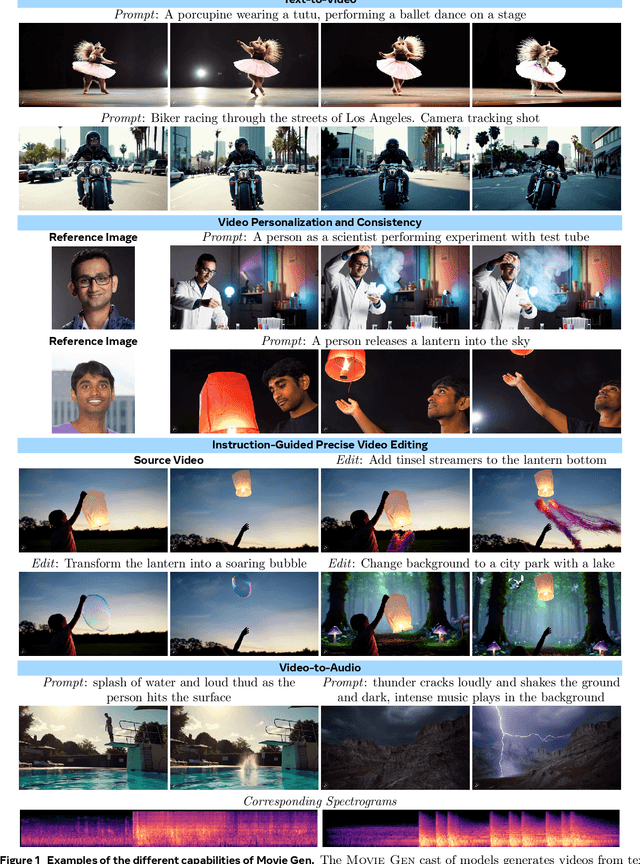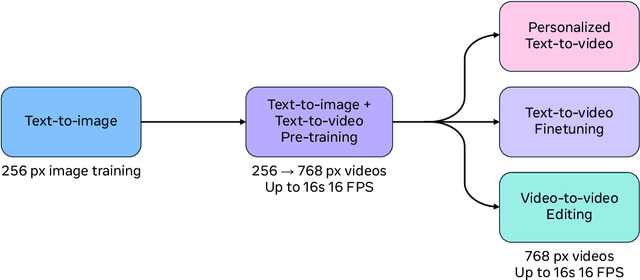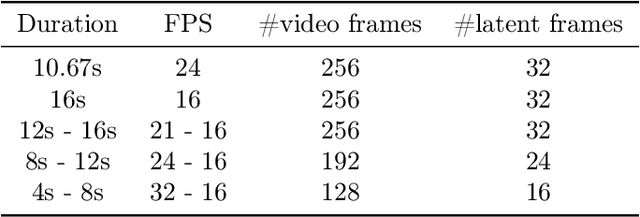Shikai Li
RealisDance-DiT: Simple yet Strong Baseline towards Controllable Character Animation in the Wild
Apr 21, 2025Abstract:Controllable character animation remains a challenging problem, particularly in handling rare poses, stylized characters, character-object interactions, complex illumination, and dynamic scenes. To tackle these issues, prior work has largely focused on injecting pose and appearance guidance via elaborate bypass networks, but often struggles to generalize to open-world scenarios. In this paper, we propose a new perspective that, as long as the foundation model is powerful enough, straightforward model modifications with flexible fine-tuning strategies can largely address the above challenges, taking a step towards controllable character animation in the wild. Specifically, we introduce RealisDance-DiT, built upon the Wan-2.1 video foundation model. Our sufficient analysis reveals that the widely adopted Reference Net design is suboptimal for large-scale DiT models. Instead, we demonstrate that minimal modifications to the foundation model architecture yield a surprisingly strong baseline. We further propose the low-noise warmup and "large batches and small iterations" strategies to accelerate model convergence during fine-tuning while maximally preserving the priors of the foundation model. In addition, we introduce a new test dataset that captures diverse real-world challenges, complementing existing benchmarks such as TikTok dataset and UBC fashion video dataset, to comprehensively evaluate the proposed method. Extensive experiments show that RealisDance-DiT outperforms existing methods by a large margin.
Uni3C: Unifying Precisely 3D-Enhanced Camera and Human Motion Controls for Video Generation
Apr 21, 2025Abstract:Camera and human motion controls have been extensively studied for video generation, but existing approaches typically address them separately, suffering from limited data with high-quality annotations for both aspects. To overcome this, we present Uni3C, a unified 3D-enhanced framework for precise control of both camera and human motion in video generation. Uni3C includes two key contributions. First, we propose a plug-and-play control module trained with a frozen video generative backbone, PCDController, which utilizes unprojected point clouds from monocular depth to achieve accurate camera control. By leveraging the strong 3D priors of point clouds and the powerful capacities of video foundational models, PCDController shows impressive generalization, performing well regardless of whether the inference backbone is frozen or fine-tuned. This flexibility enables different modules of Uni3C to be trained in specific domains, i.e., either camera control or human motion control, reducing the dependency on jointly annotated data. Second, we propose a jointly aligned 3D world guidance for the inference phase that seamlessly integrates both scenic point clouds and SMPL-X characters to unify the control signals for camera and human motion, respectively. Extensive experiments confirm that PCDController enjoys strong robustness in driving camera motion for fine-tuned backbones of video generation. Uni3C substantially outperforms competitors in both camera controllability and human motion quality. Additionally, we collect tailored validation sets featuring challenging camera movements and human actions to validate the effectiveness of our method.
Movie Gen: A Cast of Media Foundation Models
Oct 17, 2024



Abstract:We present Movie Gen, a cast of foundation models that generates high-quality, 1080p HD videos with different aspect ratios and synchronized audio. We also show additional capabilities such as precise instruction-based video editing and generation of personalized videos based on a user's image. Our models set a new state-of-the-art on multiple tasks: text-to-video synthesis, video personalization, video editing, video-to-audio generation, and text-to-audio generation. Our largest video generation model is a 30B parameter transformer trained with a maximum context length of 73K video tokens, corresponding to a generated video of 16 seconds at 16 frames-per-second. We show multiple technical innovations and simplifications on the architecture, latent spaces, training objectives and recipes, data curation, evaluation protocols, parallelization techniques, and inference optimizations that allow us to reap the benefits of scaling pre-training data, model size, and training compute for training large scale media generation models. We hope this paper helps the research community to accelerate progress and innovation in media generation models. All videos from this paper are available at https://go.fb.me/MovieGenResearchVideos.
CosmicMan: A Text-to-Image Foundation Model for Humans
Apr 01, 2024Abstract:We present CosmicMan, a text-to-image foundation model specialized for generating high-fidelity human images. Unlike current general-purpose foundation models that are stuck in the dilemma of inferior quality and text-image misalignment for humans, CosmicMan enables generating photo-realistic human images with meticulous appearance, reasonable structure, and precise text-image alignment with detailed dense descriptions. At the heart of CosmicMan's success are the new reflections and perspectives on data and models: (1) We found that data quality and a scalable data production flow are essential for the final results from trained models. Hence, we propose a new data production paradigm, Annotate Anyone, which serves as a perpetual data flywheel to produce high-quality data with accurate yet cost-effective annotations over time. Based on this, we constructed a large-scale dataset, CosmicMan-HQ 1.0, with 6 Million high-quality real-world human images in a mean resolution of 1488x1255, and attached with precise text annotations deriving from 115 Million attributes in diverse granularities. (2) We argue that a text-to-image foundation model specialized for humans must be pragmatic -- easy to integrate into down-streaming tasks while effective in producing high-quality human images. Hence, we propose to model the relationship between dense text descriptions and image pixels in a decomposed manner, and present Decomposed-Attention-Refocusing (Daring) training framework. It seamlessly decomposes the cross-attention features in existing text-to-image diffusion model, and enforces attention refocusing without adding extra modules. Through Daring, we show that explicitly discretizing continuous text space into several basic groups that align with human body structure is the key to tackling the misalignment problem in a breeze.
OrthoPlanes: A Novel Representation for Better 3D-Awareness of GANs
Sep 27, 2023Abstract:We present a new method for generating realistic and view-consistent images with fine geometry from 2D image collections. Our method proposes a hybrid explicit-implicit representation called \textbf{OrthoPlanes}, which encodes fine-grained 3D information in feature maps that can be efficiently generated by modifying 2D StyleGANs. Compared to previous representations, our method has better scalability and expressiveness with clear and explicit information. As a result, our method can handle more challenging view-angles and synthesize articulated objects with high spatial degree of freedom. Experiments demonstrate that our method achieves state-of-the-art results on FFHQ and SHHQ datasets, both quantitatively and qualitatively. Project page: \url{https://orthoplanes.github.io/}.
UnitedHuman: Harnessing Multi-Source Data for High-Resolution Human Generation
Sep 25, 2023Abstract:Human generation has achieved significant progress. Nonetheless, existing methods still struggle to synthesize specific regions such as faces and hands. We argue that the main reason is rooted in the training data. A holistic human dataset inevitably has insufficient and low-resolution information on local parts. Therefore, we propose to use multi-source datasets with various resolution images to jointly learn a high-resolution human generative model. However, multi-source data inherently a) contains different parts that do not spatially align into a coherent human, and b) comes with different scales. To tackle these challenges, we propose an end-to-end framework, UnitedHuman, that empowers continuous GAN with the ability to effectively utilize multi-source data for high-resolution human generation. Specifically, 1) we design a Multi-Source Spatial Transformer that spatially aligns multi-source images to full-body space with a human parametric model. 2) Next, a continuous GAN is proposed with global-structural guidance and CutMix consistency. Patches from different datasets are then sampled and transformed to supervise the training of this scale-invariant generative model. Extensive experiments demonstrate that our model jointly learned from multi-source data achieves superior quality than those learned from a holistic dataset.
3DHumanGAN: Towards Photo-Realistic 3D-Aware Human Image Generation
Dec 14, 2022Abstract:We present 3DHumanGAN, a 3D-aware generative adversarial network (GAN) that synthesizes images of full-body humans with consistent appearances under different view-angles and body-poses. To tackle the representational and computational challenges in synthesizing the articulated structure of human bodies, we propose a novel generator architecture in which a 2D convolutional backbone is modulated by a 3D pose mapping network. The 3D pose mapping network is formulated as a renderable implicit function conditioned on a posed 3D human mesh. This design has several merits: i) it allows us to harness the power of 2D GANs to generate photo-realistic images; ii) it generates consistent images under varying view-angles and specifiable poses; iii) the model can benefit from the 3D human prior. Our model is adversarially learned from a collection of web images needless of manual annotation.
Fast-Vid2Vid: Spatial-Temporal Compression for Video-to-Video Synthesis
Jul 11, 2022



Abstract:Video-to-Video synthesis (Vid2Vid) has achieved remarkable results in generating a photo-realistic video from a sequence of semantic maps. However, this pipeline suffers from high computational cost and long inference latency, which largely depends on two essential factors: 1) network architecture parameters, 2) sequential data stream. Recently, the parameters of image-based generative models have been significantly compressed via more efficient network architectures. Nevertheless, existing methods mainly focus on slimming network architectures and ignore the size of the sequential data stream. Moreover, due to the lack of temporal coherence, image-based compression is not sufficient for the compression of the video task. In this paper, we present a spatial-temporal compression framework, \textbf{Fast-Vid2Vid}, which focuses on data aspects of generative models. It makes the first attempt at time dimension to reduce computational resources and accelerate inference. Specifically, we compress the input data stream spatially and reduce the temporal redundancy. After the proposed spatial-temporal knowledge distillation, our model can synthesize key-frames using the low-resolution data stream. Finally, Fast-Vid2Vid interpolates intermediate frames by motion compensation with slight latency. On standard benchmarks, Fast-Vid2Vid achieves around real-time performance as 20 FPS and saves around 8x computational cost on a single V100 GPU.
StyleGAN-Human: A Data-Centric Odyssey of Human Generation
Apr 25, 2022



Abstract:Unconditional human image generation is an important task in vision and graphics, which enables various applications in the creative industry. Existing studies in this field mainly focus on "network engineering" such as designing new components and objective functions. This work takes a data-centric perspective and investigates multiple critical aspects in "data engineering", which we believe would complement the current practice. To facilitate a comprehensive study, we collect and annotate a large-scale human image dataset with over 230K samples capturing diverse poses and textures. Equipped with this large dataset, we rigorously investigate three essential factors in data engineering for StyleGAN-based human generation, namely data size, data distribution, and data alignment. Extensive experiments reveal several valuable observations w.r.t. these aspects: 1) Large-scale data, more than 40K images, are needed to train a high-fidelity unconditional human generation model with vanilla StyleGAN. 2) A balanced training set helps improve the generation quality with rare face poses compared to the long-tailed counterpart, whereas simply balancing the clothing texture distribution does not effectively bring an improvement. 3) Human GAN models with body centers for alignment outperform models trained using face centers or pelvis points as alignment anchors. In addition, a model zoo and human editing applications are demonstrated to facilitate future research in the community.
 Add to Chrome
Add to Chrome Add to Firefox
Add to Firefox Add to Edge
Add to Edge